

Buddies: Soldiers and Animals in World War II. Fall 1996, Vol. 28, No. 3 Buddies Soldiers and Animals in World War II By Lisa B.
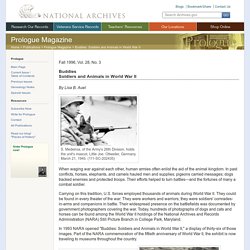
Auel. The Parachuting Dogs of the British Army in World War II. Brian was a tough paratrooper.
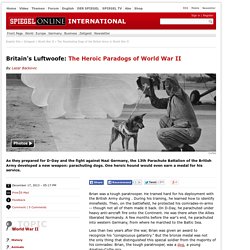
He trained hard for his deployment with the British Army during . During his training, he learned how to identify minefields. Then, on the battlefield, he protected his comrades-in-arms -- though not all of them made it back. America on the Homefront. Introduction The following is a selection of records compiled from NARA's Northeast Region at Boston that illustrate different aspects of life on the homefront during World War II.
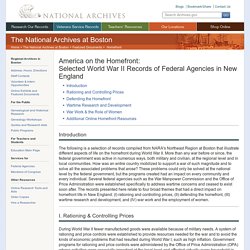
More than any war before or since, the federal government was active in numerous ways, both military and civilian, at the regional level and in local communities. How was an entire country mobilized to support a war of such magnitude and to solve all the associated problems that arose? These problems could only be solved at the national level by the federal government, but the programs created had an impact on every community and every individual. Several federal agencies such as the War Manpower Commission and the Office of Price Administration were established specifically to address wartime concerns and ceased to exist soon after.
The WASP: First in Flight (Stories from the Veterans History Project of the Library of Congress) A WASP Among Eagles: A Woman Military Test Pilot in World War II. A WASP Among Eagles: A Woman Military Test Pilot in World War II by Ann Baumgartner Carl Chapter 5: WASPS In 1941, like a virulent disease, the war spread throughout Europe.
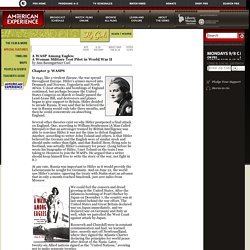
Hitler's armies moved into Denmark and Norway, Yugoslavia and North Africa. U-boat attacks and bombings of England continued, but perhaps because the United States Congress on March 11 finally passed the Lend-Lease Bill, and destroyers and planes began to give support to Britain, Hitler decided to invade Russia. It was said that he believed the war in Russia would only take three months, and then he could concentrate on absorbing England. Several other theories exist on why Hitler postponed a final attack on England. At any rate, Russia was important to Hitler as it would provide the Lebensraum he sought for Germany. Female WWII Pilots: The Original Fly Girls. WASP (from left) Frances Green, Margaret Kirchner, Ann Waldner and Blanche Osborn leave their B-17, called Pistol Packin' Mama, during ferry training at Lockbourne Army Air Force base in Ohio.
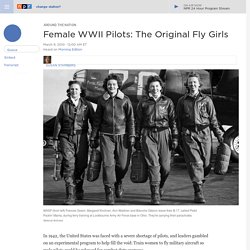
They're carrying their parachutes. National Archives hide caption toggle caption National Archives In 1942, the United States was faced with a severe shortage of pilots, and leaders gambled on an experimental program to help fill the void: Train women to fly military aircraft so male pilots could be released for combat duty overseas. The group of female pilots was called the Women Airforce Service Pilots — WASP for short.
"Now in 1944, it is on the record that women can fly as well as men," Arnold said. The LOC.GOV Wise Guide : Lamb Day. During World War II, civil rights groups and black professional organizations pressed the government to provide training for black pilots on an equal basis with whites.
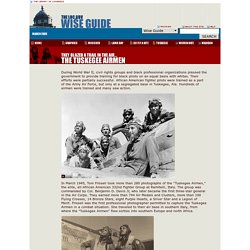
Their efforts were partially successful. African American fighter pilots were trained as a part of the Army Air Force, but only at a segregated base in Tuskegee, Ala. Hundreds of airmen were trained and many saw action. Tuskegee Airmen - World War II. Overview: Legends of Tuskegee. Learn more about the relationship between Tuskegee Institute and The Tuskegee Airmen.

Learn more about one Tuskegee Airman, Robert M. Glass. Many of the photographs in this exhibit were taken by Toni Frissell (1907-1988). She took photographs of the Tuskegee Airmen while on a mission sponsored by the U.S. government to document war conditions in Europe. Taken in March 1945, her photographs may possibly be the only photos taken of the Airmen in Europe by a professional photographer. In spite of adversity and limited opportunities, African Americans have played a significant role in U.S. military history over the past 300 years. "Tuskegee Airmen" refers to all who were involved in the so-called "Tuskegee Experiment," the Army Air Corps program to train African Americans to fly and maintain combat aircraft. The military selected Tuskegee Institute to train pilots because of its commitment to aeronautical training.
Selected Bibliography Netscape users: Click here for printable text version. A World in Flames: World War II Facts. World War II: Home Front Facts. World War II Fast Facts. Here's what you need to know about World War II, which lasted from 1939 to 1945.
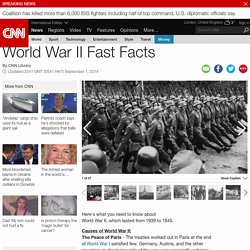
Causes of World War II:The Peace of Paris - The treaties worked out in Paris at the end of World War I satisfied few. Germany, Austria, and the other countries on the losing side of the war were especially unhappy with the Paris Agreement, which required them to give up arms and make reparations. Germany agreed to sign the Treaty of Versailles only after the victorious countries threatened to invade if Germany did not sign it. The Japanese Attacked Pearl Harbor. Pearl Harbor - World War II. The Japanese plan was simple: Destroy the Pacific Fleet.

That way, the Americans would not be able to fight back as Japan’s armed forces spread across the South Pacific. World War II: Why is it so important 70 years later? World War II is a huge topic.

There are many sources both online and in print form. Primary Source materials: The Avalon Project at Yale University is a digital library relating to law, history and diplomacy. World War I and World War II Posters:Prints and Photographs Division. World War II - Battles, Facts, Videos & Pictures - History.com. World War II. Military Resources: World War II. NARA Resources. Facts Summary Information. Facts, information and articles about World War II, 1939-1945 USS Arizona Pearl Harbor World War II Facts Dates September 1, 1939 – September 2, 1945 Location Europe, Pacific, Atlantic, South-East Asia, China, Middle East, Mediterranean and Northern Africa.
Commanders. Truman Library. World War II resources (Virtual Programs & Services, Library of Congress) Compiled by Mark F. Hall, Digital Reference Specialist.